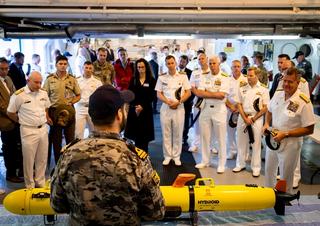About the Defence Industry Roundtable Series 2
The release of the 2023 Defence Strategic Review (DSR) represents a fundamental realignment of Australia’s strategic policy, with profound implications for the Department of Defence and Australia’s broader defence industry community. This includes shaping the contours and objectives of the Australian Government’s forthcoming Defence Industry Development Statement. In that context, from July – September 2023, the United States Studies Centre (USSC) convened its second Defence Industry Roundtable series, bringing together a total of 30 government and department officials, industry figures and experts from across the defence industry and technology landscape, for focused, closed-door discussions on key themes, challenges and opportunities surfaced by the DSR for Australian defence industry and for the government’s forthcoming Defence Industry Development Statement.1
The whole-of-nation mandate of the DSR – and subsequently the Defence Industry Development Statement and AUKUS – requires a reinvigoration of the way in which stakeholders across the defence enterprise engage to solve common problems. In bringing together a wide variety of stakeholders for multiple roundtables, this series sought to encourage a more granular conversation on the implications of the implementation of the DSR for the Defence Industry Development Statement and for AUKUS.
This outcomes report highlights 13 key findings from these discussions, identifying points of synergy and divergence between the perspectives of key stakeholders across the broader Australian defence industry community.
This outcomes report highlights 13 key findings from these discussions, identifying points of synergy and divergence between the perspectives of key stakeholders across the broader Australian defence industry community. Key themes included: divergent perceptions of who should shoulder the burden of risk; government communication regarding the intent of key initiatives like AUKUS to avoid misperception amongst industry; the tension between speed to capability and fostering innovation; and continued industry concerns regarding the burdens of compliance with Australian and US defence trade controls.
Reforming the government-industry relationship
1. Business as usual, no more
Stakeholders across the Australian defence industrial community recognise that, in order to implement the recommendations of the Defence Strategic Review (DSR), they must collectively rethink the nature of their relationship with each other. It’s clear that, as the DRS stated, business-as-usual will no longer cut it.
For its part, the Defence Department has identified two near-term priorities for reimagining the industry-government relationship: maximising strategic alignment and expediating capability cycles.
From the Australian Government’s perspective, this is more about reforming processes and culture within the Department of Defence (the Department) in order to be a better partner to the industry, rather than about fundamentally reinventing the way in which the Australian defence industry operates. For its part, the Defence Department has identified two near-term priorities for reimagining the industry-government relationship: maximising strategic alignment and expediating capability cycles. Firstly, the Department is seeking reforms in its Capability Acquisition and Sustainment Group (CASG), as well as injections of human capital, to streamline existing capability management processes to work at the speed of strategic relevance.2 Secondly, and relatedly, the Department is seeking ways to bridge the ‘valley of death’ in the capability development process between concept and deployment.3

2. Reconceptualising risk
Stakeholders broadly agree that the ways in which risk is conceptualised, metabolised, and rewarded within the Department and across the public service will dictate the success of the implementation of the DSR, including future capability development. However, there are discernible differences of opinion between key stakeholders as to which entities should assume the lion’s share of specific forms of risk.
Australian industry stakeholders have suggested a reallocation of risk across industry and government and have identified the need for a clearer communication of responsibility for managing risk early in the contract negotiation process. Whilst industry is prepared to take on a greater degree of risk, there remains a strong desire for the government to make clearer statements of intent with respect to how much risk it is prepared to assume in return. In addition, the industry requires government to demonstrate continuity of policy settings, without this, industry will assume a conservative relationship to risk. A failure to achieve this balance presents an even greater risk to the Australian defence industry: the loss of corporate and intellectual knowledge to overseas customers and stakeholders. In other words, should government fail to demonstrate commitment to policy settings and fail to come to a tacit understanding with the industry on risk burden sharing and thresholds, industry will be forced to focus on overseas markets to sustain commerciality at the expense of the local defence industry ecosystem.
Whilst industry is prepared to take on a greater degree of risk, there remains a strong desire for government to make clearer statements of intent with respect to how much risk it is prepared to assume in return.
From the perspective of the government, the Department of Defence – and the Australian Public Service more broadly – will also need to affect a culture shift that embraces, if not rewards, risk-taking. Ultimately, this shift is required to keep pace with the strategic circumstances Australia faces as current approaches to risk management do not accord with the nation’s strategic threats.4 Moreover, this shift will be crucial to enhancing Australia’s defence innovation ecosystem and expediting capability development. Driving culture change will necessarily involve developing new risk and reward systems, including incentives and protections for Department employees/capability managers to “embrace failure” in the interests of accelerating the delivery of new disruptive technologies and capabilities to the Australian Defence Force (ADF) within a five-year time horizon. AUKUS Pillar II has been identified as a pathfinder in this regard, with government stakeholders suggesting Pillar II should not only reform Australia’s domestic capability acquisition and risk processes but also “create a new way of operating across the board” for the three AUKUS countries’ defence bureaucracies. This cultural change will need to be supported by the broader government, with stakeholders noting existing oversight mechanisms would need to accept a more flexible conceptualisation of risk and to provide sufficient top-level cover for implementers to operationalise this new culture in a meaningful way.
3. Effective communication
The Department of Defence, government and industry are all aware of the need to enhance the quality and regularity of their strategic communication in the interests of better understanding and aligning each constituency’s strategy and bottom-line objectives. This is especially pertinent with respect to AUKUS and the DSR. The government and the Department both recognise the need to engage with industry in the early phases of strategy and capability development processes, rather than treating such engagement as an “afterthought”. More broadly, stakeholders agree that engagement between Department of Defence officials, personnel and industry needs to be ambitious in its level of granularity and collaboration.
Building on their desire for a clearer division of risk and a stronger signal of intent, industry stakeholders held up the ‘rolling wave’ policy as a successful historical example of investment signalling.
Although industry stakeholders reported marked improvements in the way the Department is signalling expectations and objections, they note that greater clarity of communication and intent from the government is essential to ensuring that the DSR is appropriately understood. To improve the quality and regularity of communication with respect to DSR implementation, the industry suggested appointing a DSR advisory board with representation from primes and SMEs as a way to foster sustained engagement, noting successful historical examples of jointly chaired government-industry advisory boards. Building on their desire for a clearer division of risk and a stronger signal of intent, industry stakeholders held up the ‘rolling wave’ policy as a successful historical example of investment signalling. Meanwhile, other stakeholders pointed to the United States’ model of bringing CEOs and senior military/policy officials together to collaborate on investment guidance and strategic direction as a successful blueprint for effective communication, suggesting this should be considered in the forthcoming Integrated Investment Plan.
At a high level, the Department holds concerns that a lack of effective communication between different stakeholders, including the use of broad narrative devices in public discussions about defence strategy, has contributed to misperceptions among some industry players about the purpose and remit of specific initiatives. For instance, there are concerns that industry interpreted the various lines of effort articulated under AUKUS Pillar II as “a cookie jar of gold” for research and development rather than as a call for discrete and disruptive capabilities to be delivered to the military on an accelerated 5-year timescale. The government also worries that industry incorrectly interpreted language in the DSR around ‘sovereignty’ and the need to balance domestic and international industrial inputs with the time-to-acquisition imperative as a signal that the government would prioritise buying capabilities “off the shelf”.

Implementing the Defence Strategic Review
4. Budget and implementation
Australian industry and government stakeholders agree that having the best policy in the world is useless without a rigorous implementation strategy. On this score, they agree that implementation stands out as a major shortcoming in historical industry policy strategies (followed closely by a lack of focus on delivering capability), including the Defence Industry Development Statement of 2016.5 In their view, ongoing policy implementation efforts need to be supported by adequate funding, even amidst competing financial pressures from across the wider defence capability portfolio and broader government budget. As it stands, however, there is a tension between the priorities and capability goals outlined in the DSR and the funding available to the Department of Defence in the near term, meaning that tough decisions about which lines of effort to prioritise will be required ahead of the FY 2024-45 Federal Budget. Notwithstanding strains evident in the forward projections, medium-term projections to 2030 indicate spending will increase to 2.3 per cent of GDP.6 This represents a 0.2 per cent lift and will equate to multiple billions of dollars of additional capital. Two questions in this regard linger: what is the place of R&D in the overall defence investment portfolio? And, more significantly, is the current investment portfolio adequate to meet the threats outlined in the DSR and the capability requirements to meet the “Future Integrated Force”?7
Internally, senior leaders within the Defence Department are moving quickly to reorganise operations in light of the DSR and AUKUS, albeit perhaps more slowly than some stakeholders would like. The top-down process to realign the Defence Department to the DSR priorities, using the allocation of the budget as a forcing function, is intended to better align strategy settings with budget processes. This approach represents a fundamental change from the Department’s previous approach of reconciling strategy and budget processes from the bottom up.
Australian industry and government stakeholders agree that having the best policy in the world is useless without a rigorous implementation strategy.
5. Degrees of sovereignty
The forthcoming Defence Industry Development Statement will need to clearly define its conceptions of “sovereignty” and “sovereign capabilities.” This will necessarily involve addressing the real or perceived overemphasis on Australian industry content as the primary determinant of sovereign defence industrial capabilities, including the use of quotas. It will also require moving towards a definition of sovereignty that is based more on concepts of degrees of control and reliable access rather than the geolocation of production or manufacturing facilities on Australian soil.8 For instance, sovereignty might mean having an assured capability to maintain and sustain key capabilities such as Joint Strike Fighters or other high-end capabilities from Australian facilities rather than developing a complete life-cycle for manufacturing in the country. Importantly, this requires a frank acknowledgement of cases in which Australia will be unable to make things domestically but where it may be able to implement industrial policy to support better sustainment and specific defence manufacturing objectives.
Understanding exactly what degree of sovereignty is required in different capability contexts or defence industrial ecosystems, such as the various streams under AUKUS, will be essential to understanding how to maximise efficiencies and negotiate effectively with international partners, including the United States.9 Indeed, determining the definition and requirements of an Australian sovereign defence industrial capability will also require engaging in parallel discussions about degrees of integration with the United States and other capable industrial partners, which may afford significant industrial uplift.10 Stakeholders agree on the need for clearer government directives to industry about what will and won’t be bought in the country, with the DSR presenting an opportunity to zero-in on what Australian sovereign capability strengths are or should be. This will also necessitate a discussion regarding sovereign manufacturing capability, particularly given that industry stakeholders continue to report that limitations in domestic manufacturing capacity thwart Australia’s capacity to produce defence articles at sufficient scale.
6. Picking winners
Stakeholders acknowledged that, to some extent, developing degrees of sovereignty and maximising Australia’s relative strengths may also require picking winners. At present, however, there is a lack of institutional knowledge about what aspects of Australian defence technology are actually genuinely world-leading. Stakeholders across the defence ecosystem acknowledge the need to develop collective domain knowledge expertise, which will require more intensive intra-industry collaboration and greater information sharing between industry and government. This will be necessary to support the government’s intention for the Defence Industry Development Statement to signal 14 strategic industrial areas of distinct advantage and value and to align these with the objectives set forth in the DSR.11 Yet the possession of world-leading technology does not automatically equate to the possession of world-leading capability. Defence industry stakeholders lamented a lack of human capital and expertise to support robust corporate functions, subsequently preventing the transformation of technological edge into successful SME(s). One of the most troublesome areas within this problem set is the development of advanced cyber competency and worthiness (see more below).12
7. Whole of government effort
Stakeholders across the defence industrial ecosystem are aware of the need to bring other government departments and non-defence industrial entities into the discussion about DSR implementation, especially once the Defence Industry Development Statement is publicly released. Stakeholders identified two key reasons for this: (1) to bring the broader government apparatus onside with necessarily shifting conceptualisations and cultures of risk, and (2) to truly nationalise Australia’s approach to national defence. Currently, non-defence departments and agencies have the opportunity to observe the DSR and its implications with a degree of passivity. Stakeholders agree there is a strong rationale for a broader national security document to achieve a whole of government approach to national defence. They note that in addition to the forthcoming National Defence Strategy, a National Security Strategy or similar could ensure greater cohesion on defence priorities across the public service. This document would represent an overarching strategy, tying together all of the existing reviews and disparate documents.

Innovation and integration
8. Speed to capability versus innovation
There is a degree of tension between the competing imperatives of speed to capability versus the development of next-generation disruptive technologies. On the one hand, the Department of Defence is acutely focused on equipping mechanisms like the new Advanced Strategic Capabilities Accelerator (ASCA) to deliver new capabilities to the Australian Defence Force within a five-year time frame. This seeks to move away from the Defence Innovation Hub’s approach, which was described as funding “science experiments”, to instead focus on delivering technologies with proven warfighting applicability at pace.13 On the other hand, this speed-to-capability imperative is in competition with what appears to many to be the main thrust of initiatives like AUKUS Pillar II, which are nominally focused on nurturing disruptive innovation as much as they are about fielding disruptive capabilities. Notwithstanding Australia’s near-term defence requirements and the attendant emphasis on proven capabilities, industry stakeholders are concerned that a focus on speed may come at the expense of innovation and result in a stunted defence innovation environment. Stakeholders noted the risk of this approach is that potentially game-changing defence-applicable technologies will fall through the cracks and/or that innovators will take their product overseas for development instead. USSC experts have highlighted that ASCA will need to figure out how to do both, delivering capability at speed at the same time as it fosters innovation with and within the private sector.14 In addition, industry stakeholders noted that maximising the potential upsides of Australia’s innovation ecosystem will require the urgent crafting of an attractive value proposition and social license to the broader community about the imperative of innovation for national security objectives.
Notwithstanding Australia’s near-term defence requirements and the attendant emphasis on proven capabilities, industry stakeholders are concerned that a focus on speed may come at the expense of innovation and result in a stunted defence innovation environment.
Addressing the tension between innovation and speed will not be easy. Participants noted the risks inherent in setting such a low bar for innovation and in preferencing speed that capability loses its technological edge within two to three years. ASCA’s job of balancing these tensions is made more difficult by the mechanism’s location within a defence bureaucracy still grappling with how best to reform its risk culture. Part of the solution to this issue may involve accelerating the timelines on which minimum viable products are transferred to the ADF in order to maximise their capability potential – in other words, putting products into service at earlier stages in order to accelerate or maximise their evolution in service. Indeed, discussants cited instances in which capability development projects on the brink of cancellation were transferred to operators before their complete maturation, ultimately resulting in the development of world-leading capabilities operating at 120 per cent of old or expected capability standards.
9. Compliance burdens
Australian defence industrial stakeholders are generally encouraged by progress in the United States on export control reform for Australia and AUKUS countries writ large, particularly the International Traffic in Arms Regulations (ITAR). This optimism is based on visible buy-in to the export control reform agenda across the US systems, including ambitious legislation proposed by congressional bodies, new initiatives announced by the Departments of State and Defense, and expressions of public support from the executive branch.15 These stakeholders are also encouraged by the new level of specificity provided by US interlocutors regarding their concerns about the integrity of various elements of Australia’s own defence export control and regulatory systems, the hereto absence of which led many in the Australian community to regard these concerns as a “red herring.”16 However, some Australian stakeholders remain concerned about the degree to which these different constituents are on-board with the more ambitious changes to ITAR,17 particularly with respect to creating a virtual defence “free trade area” between the three countries18 as well as the scope of the changes that Australia will be expected to affect to its own processes to make them “sufficiently comparable” to those of the United States. These concerns are particularly acute considering that the State Department – traditionally the locus of the most stalwart opposition to ITAR reform within the US system – will reportedly have carriage of defining these requirements and of signing-off on their veracity.
Indeed, it is a misnomer that export control reforms in the United States will, on balance, reduce compliance requirements for Australian defence industry companies working with the Pentagon.
Australian defence industry stakeholders generally share a desire for US export control reform to reduce cumbersome compliance burdens. Yet paradoxically, efforts to reform and harmonise export control and other regulatory mechanisms between Australia, the United Kingdom, and the United States, including greater controls on “deemed exports”, may, in fact, increase compliance burdens for industrial entities. This may not only stifle Australian innovation for technology with military application but also negatively affect the innovation ecosystem for dual-use technologies with civilian purposes and commerciality. For several experienced experts, draft Australian legislation released for brief public consultation in early November 2023 only confirmed these concerns.19 Australian stakeholders also remain alert to the fact that there is much greater interest in the United States in the technology-sharing components of AUKUS than in a broader federation of defence industrial supply chains, which could complicate efforts to enhance Australian defence industrial sovereignty.
10. The trade-offs between integration and compliance
In short, this is a catch-22 for Australia. On the one hand, the Australian Government is unlikely to compromise on relaxing requirements for defence industry entities to meet certain cyber security and other compliance requirements necessary to work with the Department of Defence. On the other hand, raising standards and compliance reporting requirements for all players could also have the effect of eliminating current or prospective sources of innovation across Australia’s network of defence supply chains. This is especially alarming considering that export control compliance requirements already disproportionately effect Australia’s small and medium-sized enterprises (SMEs), who often do not possess the financial nor human capital to cope with navigating this process. This is problematic considering that it has historically been from these entities that many of Australia’s niche technological advantages have originated, and the enduring need to cultivate a more vibrant and supportive defence innovation environment in this country.20 While primes generally have the resources to manage compliance requirements and regard these as “the cost of doing business” with the United States,21 the government and the Department will likely need to consider ways to offset these burdens for SMEs if these entities are to be adequately incentivised.
Export control reform is only one part of a more complex puzzle to streamline defence industrial and technology collaboration between Australia, the United Kingdom and the United States. The DSR called for an acceleration of the transfer of Defence’s Positive Vetting (PV) authorities to the Top-Secret Privileged Access (TSPA) authority to ease workforce pressures and enhance allied and AUKUS industrial and technological collaboration.22 Discussants were quick to point to increased requests for these authorities resulting from AUKUS and other initiatives as one of the primary strains on the current defence trade control system and reiterated the need for a mutually recognisable clearance process between Australia, the United States and the United Kingdom to expedite trilateral cooperation.
Procurement and digital transformation
11. Reforming CASG
The DSR recommended a fundamental reform of the Department of Defence’s procurement processes and acknowledged that business must be done differently. Discussants noted two factors must be prioritised in this endeavour: (1) how CASG strategically aligns and partners with industry for success, and; (2) expediating the path through the capability lifecycle – both factors are needed to help avoid the valley of death. Defence Department stakeholders affirmed this would be a major focus for the Defence Industry Development Statement. Other participants observed that making good on these pledges will be key, given that procurement processes did not materially improve from the 2006 to the 2010 industry policy strategies and have traditionally stopped short of addressing the most serious of implementation challenges. To that end, some participants proposed a new model whereby industry assist defence with the introduction and operational release of new capabilities to expedite their delivery to the ADF. This would be a strong departure from existing processes which have kept industry at arms-length, stopping at the delivery of major equipment and products. Defence Department stakeholders also noted “sensible engagement on procurement and CASG reform” would be beneficial in order to ascertain what is and is not realistic with regard to the procurement process reforms recommended by the DSR.
The DSR recommended a fundamental reform of the Department of Defence’s procurement processes and acknowledged that business must be done differently.
12. Digital transformation and cyber security
Discussion surfaced a genuine interest from participants in ‘Industry 4.0’, and digital transformation as tools to advance manufacturing processes, with advanced cloud technology and other innovations mooted to present significant opportunities for streamlining or even reimagining existing processes. Government and industry stakeholders agreed on the imperative for greater cyber awareness and uplift across the entirety of the defence supply chain before advanced technology can be developed and shared safely, with government policy adjustments required to drive these reforms. However, they also agreed that a delicate balance must be struck so that the burden of cyber compliance doesn’t cripple smaller players in the defence industrial ecosystem. Discussants stated this would be a difficult task, pointing to the fact that within a group of 1400 Defence Industry Security Program members, 90 per cent possess basic entry-level cybersecurity worthiness, with only six companies possessing more advanced levels of cyber maturity.23 There is an expectation that primes have a “positive obligation to ensure the security of supply chains and the worthiness of those supply chains” especially in regards to their work with SME’s and ‘below the line’ contractors.24
Defence Department stakeholders referred to the importance of leveraging ‘Industry 4.0’ – a digital paradigm offering the promise of shortened capability delivery times. Moreover, participants reflected on the significant uplift in integration and experimentation digital engineering is able to provide and discussed cases where it had been used to shrink production time for certain Joint Strike Fighter components from eight weeks to eight days. To be sure, digital transformation also holds promise for AUKUS Pillar I, indeed Australia is faced with the unique opportunity to develop the most advanced 4th generation manufacturing facilities in the world by building a clean sheet site at Osbourne in South Australia.

Looking ahead
13. Iterative development
Stakeholders across the defence industrial ecosystem are aware that the recommendations set forth in the DSR will not be the end-state for efforts to develop Australia’s sovereign defence industrial capabilities. Though these provide important waypoints and distinct objectives for meeting near to mid-term national strategic challenges, industry and government stakeholders alike are appropriately focused on adopting an iterative philosophy to procedural and systems reform to make these more flexible and responsive to evolving circumstances. Continued engagement and consultation across government, the Defence Department, private sector and research silos will be critical to ensuring the future success of Australia’s sovereign defence industrial capabilities and industrial uplift through collaboration with allies.







